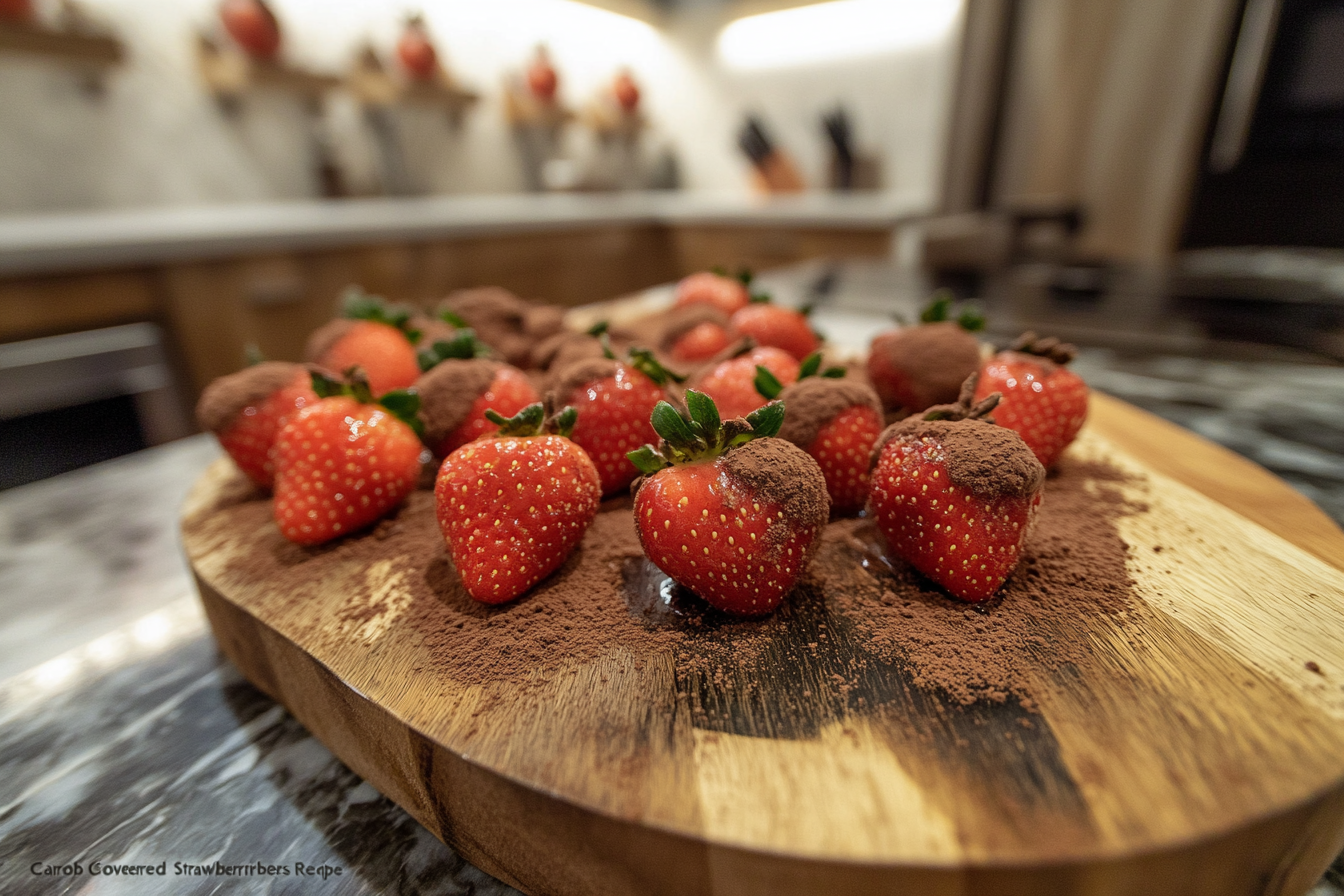Stop Chocolate-Covered Strawberries from Sweating are a delightful treat, but keeping them fresh and visually appealing can be tricky. One of the biggest challenges is preventing them from “sweating”—the buildup of moisture on the chocolate’s surface. This guide explains why this happens and provides practical tips to keep your chocolate-covered strawberries sweat-free and looking their best.
Why Do Chocolate-Covered Strawberries Sweat?
Understanding the science behind sweating is essential to prevent it.
The Science Behind Sweating: Condensation Explained
Sweating occurs when moisture from the air condenses on the cold surface of the chocolate. This is particularly common when strawberries are moved from a cold environment, like a refrigerator, to a warmer, humid room.
How Temperature Differences Cause Moisture Build-Up
When the chocolate-covered strawberries are colder than the surrounding air, water vapor from the air condenses into droplets on the chocolate’s surface. This condensation results in a sticky, unappealing coating.
The Role of Humidity in Creating a Sweaty Appearance
High humidity exacerbates sweating. The more moisture there is in the air, the more likely condensation will occur. A humid environment can also make the chocolate lose its firm texture and glossy finish.
Factors That Contribute to Sweating
- Refrigeration: Storing chocolate-covered strawberries in the fridge can make them prone to sweating when taken out.
- High Humidity: A humid kitchen or storage area increases the likelihood of condensation.
- Improper Drying: Moisture left on the strawberries before dipping can lead to sweating.
How to Keep Chocolate-Covered Strawberries Sweat-Free
Follow these steps to prevent sweating and maintain the strawberries’ freshness and appearance.
1. Preparing Strawberries Correctly
Proper preparation sets the foundation for sweat-free chocolate-covered strawberries.
Washing and Thoroughly Drying Strawberries
- Gently wash strawberries under cold running water to remove dirt and pesticides.
- Dry them thoroughly with a paper towel.
- Let the strawberries air-dry completely for at least 30 minutes before dipping to ensure no moisture remains.
Avoiding Excess Moisture Before Dipping
Even small water droplets can disrupt the chocolate’s ability to adhere and set properly. Ensure strawberries are completely dry before dipping.
2. Dipping Chocolate the Right Way
Using the right chocolate and dipping technique can make a significant difference.
Using Properly Tempered Chocolate
- Tempering chocolate stabilizes its cocoa butter, giving it a firm texture and shiny finish.
- Properly tempered chocolate is less prone to sweating and ensures a smooth, even coating.
Adding a Barrier Layer
- Dip strawberries quickly into the melted chocolate to avoid prolonged exposure to warm chocolate.
- Ensure the coating is even and covers the entire surface to minimize exposure to air.
3. Managing Temperature Differences
Temperature control is crucial in preventing condensation.
Keeping Strawberries at Room Temperature Before Dipping
- Bring strawberries to room temperature before dipping to reduce the temperature difference between the chocolate and fruit.
Allowing Chocolate to Set at Room Temperature
- Let the dipped strawberries set on parchment paper at room temperature for 30–60 minutes before refrigerating.
4. Storing Chocolate-Covered Strawberries Correctly
Proper storage minimizes sweating and helps maintain freshness.
Storing in a Cool, Dry Place
- If possible, avoid refrigeration entirely and store the strawberries in a cool, dry place (below 70°F) for up to 24 hours.
Using Parchment Paper
- Place strawberries on parchment paper to prevent sticking and allow air circulation.
Refrigerating Only When Necessary
- If you must refrigerate, store the strawberries in an airtight container lined with a paper towel to absorb moisture.
Long-Term Maintenance and Additional Tips
1. Storing in Low-Humidity Environments
- Use a dehumidifier or air conditioner to maintain low humidity levels in your kitchen.
- For extra moisture control, place silica gel packs or a small bowl of uncooked rice in the storage container to absorb excess humidity.
2. Presentation and Serving Tips
Serve Freshly Made
- Chocolate-covered strawberries are best enjoyed on the day they are made. Prepare them as close to serving time as possible to reduce the risk of sweating.
Avoid Extended Refrigeration
- Only refrigerate if necessary, and let the strawberries sit at room temperature for 10–15 minutes before serving to avoid condensation.
3. Creative Alternatives to Reduce Sweating
Using Candy Melts or Compound Chocolate
- Candy melts or compound chocolate harden more quickly and are less prone to sweating, as they are formulated with stabilizers.
Wrapping Individually
- For special events, wrap each strawberry in clear cellophane to reduce direct exposure to air and humidity.
Frequently Asked Questions (FAQs)
1. Why Do Strawberries Sweat in the Fridge?
Sweating happens because the cold surface of the chocolate causes moisture from the humid air to condense when the strawberries are removed from the fridge.
2. How Long Can Chocolate-Covered Strawberries Last Without Sweating?
If stored correctly in a cool, dry place, chocolate-covered strawberries can last up to 24 hours without sweating. Beyond that, they are more likely to develop condensation, especially in humid environments.
Advanced Tips for Preventing Sweating
1. Create a Protective Barrier
A protective layer can prevent moisture from reaching the chocolate and causing it to sweat.
- Coat Strawberries in Sugar First: Before dipping, lightly coat the strawberries with granulated sugar to absorb excess moisture. This creates a barrier between the fruit and the chocolate.
- Apply a Thin Layer of Melted Candy Melts: Use candy melts as a base layer before applying regular chocolate. Candy melts harden faster and help seal the surface of the strawberry.
2. Use Stabilizers in Your Chocolate
Enhance the performance of your chocolate to make it more resistant to sweating:
- Add 1 teaspoon of coconut oil per 1 cup of chocolate to improve texture and stability.
- Use compound chocolate or candy melts, which are specifically designed to harden quickly and resist moisture.
3. Chill the Chocolate, Not the Strawberries
Refrigerate the chocolate coating itself, not the dipped strawberries:
- After dipping, place strawberries in a cool room (not the fridge) to let the chocolate set naturally.
- If you must refrigerate, place a tray of just the melted chocolate in the fridge to cool slightly, then dip the strawberries.
4. Keep the Chocolate Thin
Thinner chocolate layers harden faster and are less prone to sticking or sweating:
- Add a tablespoon of vegetable oil or melted butter to thin the chocolate.
- Avoid overly thick coatings by gently tapping the dipped strawberry against the side of the bowl to remove excess chocolate.
Creative Storage Solutions
1. Airtight Container with Absorbent Layers
Use an airtight container with layers of paper towels to manage condensation:
- Line the bottom with a paper towel to absorb moisture.
- Place strawberries in a single layer, ensuring they don’t touch each other.
- Add another layer of paper towel on top to further absorb moisture.
2. Individual Wrapping
For special events or gifting, wrap each strawberry individually:
- Use small squares of wax paper, parchment paper, or cellophane to wrap each strawberry tightly but gently.
- Secure the wrapping with a ribbon or twist tie to keep moisture out.
3. Keep Them Cool with Dry Ice
If storing strawberries for an extended time, use dry ice in a cooler instead of refrigeration. Dry ice creates a cold, dry environment that minimizes humidity and prevents sweating.
Pro Tips for Preparing and Dipping
1. Handle Strawberries with Care
- Avoid bruising the strawberries, as damaged areas release more moisture.
- Select firm, ripe strawberries for dipping. Overripe strawberries are juicier and more prone to sweating.
2. Use the Right Chocolate Temperature
The chocolate’s temperature affects how well it adheres and hardens:
- Chocolate that is too hot may cause the strawberry’s natural juices to seep out.
- Use a thermometer to maintain the optimal temperature:
- Dark Chocolate: 88–90°F (31–32°C)
- Milk Chocolate: 86–88°F (30–31°C)
- White Chocolate: 84–86°F (29–30°C)
3. Apply a Double-Dip Technique
For a more durable coating:
- Dip the strawberries once and let the first layer harden at room temperature.
- Dip them again for a thicker, more secure layer of chocolate that minimizes sweating.
4. Position Strawberries Strategically
Place dipped strawberries on a cooling rack instead of parchment paper:
- This allows air to circulate under the strawberries, preventing the pooling of moisture or chocolate at the base.
Presentation Tips for Serving
1. Garnish to Disguise Sweating
If sweating occurs, camouflage it with decorative elements:
- Dusting: Lightly dust strawberries with cocoa powder, powdered sugar, or shredded coconut.
- Drizzles: Add a second layer of chocolate drizzle (white, dark, or colored) to cover any imperfections.
2. Serve with Quick-Absorbing Sides
Pair chocolate-covered strawberries with items that can absorb excess moisture:
- Serve on a platter lined with cookies, crackers, or wafers.
- Add fresh herbs (e.g., mint leaves) as both a garnish and a natural moisture absorber.
Creative Alternatives to Traditional Chocolate Coatings
If sweating is a persistent issue, try alternative coatings that are more resistant to moisture.
1. Yogurt Coating
Dip strawberries in Greek yogurt mixed with honey, then freeze for a creamy and sweat-resistant coating.
2. Hard Candy Shell
Use a hard candy glaze instead of chocolate for a glossy, stable finish. Create this by heating sugar, water, and corn syrup until it reaches the hard-crack stage, then dip the strawberries.
3. Edible Glitter or Sprinkles
Roll dipped strawberries in edible glitter, crushed nuts, or sprinkles while the chocolate is still wet. These toppings can mask minor sweating issues and add texture.
Maintenance and Serving Strategies
1. Serve Freshly Made
Chocolate-covered strawberries are best enjoyed on the same day they are made. If serving them later, ensure they are stored in a low-humidity, cool environment.
2. Minimize Temperature Shifts
Avoid moving strawberries between drastically different temperatures:
- Let them sit at room temperature for 15–30 minutes after refrigeration before serving to reduce condensation.
3. Quick Fix for Sweating
If sweating occurs, gently blot the moisture with a clean paper towel or microfiber cloth. Avoid wiping the chocolate surface to prevent smudging.
Frequently Asked Questions
1. Can I Freeze Chocolate-Covered Strawberries to Prevent Sweating?
Yes, but with precautions. Freezing can preserve them for longer periods, but condensation will occur when they thaw. Serve them frozen or partially thawed to avoid sweating.
2. How Long Can Chocolate-Covered Strawberries Last?
At room temperature, they typically last 24 hours. In the fridge, they can last up to 48 hours if stored properly in a low-humidity environment.
3. Is There a Way to Fix Sweaty Strawberries?
If sweating occurs:
- Refrigerate them briefly to firm up the chocolate.
- Lightly blot away condensation before serving.

